As specialty medications rapidly approach half of all medication spending, they are creating new affordability challenges for consumers and clients.
One unique aspect of specialty medications is that costs occur across both the medical and pharmacy benefits. Currently, medications billed under the medical benefit account for 40% of specialty spend.1 As a result, plan sponsors want pharmacy benefit managers to find better ways to manage these costs across both benefits.
Pharmacy vs. medical benefit medications
To understand rising costs related to specialty medications, it’s helpful to briefly review how they differ from traditional drugs. Specialty pharmaceuticals are often biologic drugs with complex molecular structures. Early specialty medications largely treated complex conditions affecting small disease populations. Now, as more specialty medications enter the market, they are increasingly utilized for more indications. Often, they replace traditional drugs as treatments.
While there are oral specialty medications, many need to be infused into a vein or injected under the skin. While sometimes administered at home by a medical professional, often these procedures occur in a hospital outpatient setting or a physician’s office. Importantly, the cost for administering the same drug can vary widely according to site of care.
The challenge with specialty medications on the medical benefit
As noted above, there is the potential for extreme cost variability when billed under the medical benefit, especially when it comes to different sites of care. The medical benefit also uses J codes for billing, which allow a wide variety of drugs to be billed with the same code.
In contrast, drugs managed under the pharmacy benefit have less cost variability due to the use of National Drug Codes (NDCs), which are more precise than the J codes used for billing on the medical benefit. Additionally, drugs on the pharmacy benefit are subject to enhanced clinical expertise and utilization management programs. Utilizing pharmacy expertise to employ these proven cost management techniques helps clients manage their specialty drug spend even more effectively.
An industry-first solution
The Optum® MedicalRx Specialty Provider Network addresses cost variability and helps manage spend in a new way. The Medical Specialty Provider Network consists of medical providers who infuse/inject targeted specialty drugs that are currently paid on the medical benefit. Under the new network terms, contracted providers continue to self-procure and administer medications and then bill Optum for the cost of the medication and administration together using standardized reimbursement rates.
This innovation allows providers to obtain medications where they see fit, leveraging their class of trade discounts, and then be reimbursed at a fair market rate that is confirmed in advance. Optum has created this innovative network to meet the provider's need to buy and bill; additionally, the network creates a mechanism that controls historic site of care variations in cost.
The benefits of this network approach are many. By using standardized reimbursement rates, it eliminates site-of-care cost inflation and variation. Providers enjoy a more predictable reimbursement timeline — up to four weeks faster than the typical medical claims billing process.
Another benefit of the MedicalRx Specialty Provider Network is a consistent member experience. By offering entry to the network to any willing provider, member disruption is mitigated. Moreover, to assist them in locating network providers, the MedicalRx Specialty Provider Network provides concierge services for members.
Above all, this approach delivers savings to clients. The drug Orencia® is a good example of how the MedicalRx Specialty Provider Network saves money. Used to treat rheumatoid arthritis, Orencia costs an average of $5,000. In comparison, the MedicalRx Specialty Provider Network cost for Orencia is $4,250, a savings of $750.
Clients who choose to implement the MedicalRx Specialty Provider Network can expect savings up to 5% on a per member per month (PMPM) basis from this program alone. 2
“The MedicalRx Specialty Provider Network truly exemplifies how Optum Rx is tackling the toughest challenges in health care through innovation,” says Dee Grein, senior vice president, product and strategy, Optum Rx. “For the first time ever, plan sponsors can achieve standardized reimbursement rates for specialty medications billed under the medical benefit and achieve significant savings while mitigating disruption for their members.”
One solution in our multi-pronged approach
The MedicalRx Specialty Provider Network represents a new way to counter the rising costs of specialty medications. However, there is no single answer to this problem. Accordingly, the MedicalRx Specialty Provider Network is just part of a broader multi-pronged approach from Optum Rx.
These specialty medication optimization solutions include Specialty Redirection, which retrospectively redirects patients to lower-cost sites of care, and MedicalRx Benefit Optimization, in which medications are sourced from a specialty pharmacy to ensure cost management.
Talk to your Optum Rx representative to learn more about the MedicalRx Specialty Provider Network and other ways you can address rising specialty costs.
Related content

Rare diseases, large costs

Drug pricing spotlight: Wound care

5 questions: Optum Rx chief pharmacy officer
Sources
- Milliman. Commercial specialty medication research 2019 benchmark projections. Accessed May 19, 2021.
- Optum Rx internal analysis.


